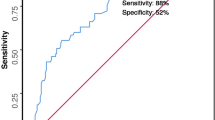Summary
Background
We investigated the applicability of both Acute Physiology And Chronic Health Evaluation II (APACHE II) and Mannheim Peritonitis Index (MPI) in transplant recipients with intestinal perforation as polymicrobial peritonitis is highly life-threatening in patients with impaired immunological defence and the course of abdominal sepsis is aberrant compared to non-immunosuppressed individuals.
Methods
In a retrospective database analysis, we validated the consistency of APACHE II and MPI in death prediction in septic peritonitis. In a matched-pair analysis we then investigated their applicability in immunosuppressed transplant recipients. The validation of the scores was performed with 125 non-immunosuppressed patients. In a matched-pair analysis 16 immunosuppressed transplant recipients were compared with 32 controls.
Results
In accordance with clinical observations, statistical analyses revealed significantly higher MPI scores in immunosuppressed transplant recipients (P = 0.0007), whereas APACHE II scores were comparable. Linear regression analysis revealed that predicted death rates derived from APACHE II and MPI differ significantly (P = 0.0344) in immunosuppressed transplant recipients compared to controls.
Conclusions
Both scores consistently serve as reliable tools for prediction of lethality in septic peritonitis but they fail in immunosuppressed organ recipients. Our findings clearly confirm that in immunosuppressed patients severe peritonitis might be present despite an a- or oligosymptomatic clinical course.



Similar content being viewed by others
References
Van Till JW, van Veen SQ, van Ruler O, et al. The innate immune response to secondary peritonitis. Shock. 2007;28(5):504–17.
Hensler T, Hecker H, Heeg K, et al. Distinct mechanisms of immunosuppression as a consequence of major surgery. Infect Immun. 1997;65(6):2283–91.
Zeitoun G, Laurent A, Rouffet F, et al. Multicentre, randomized clinical trial of primary versus secondary sigmoid resection in generalized peritonitis complicating sigmoid diverticulitis. Br J Surg. 2000;87(10):1366–74.
Novotny A, Emmanuel K, Matevossian E, et al. Use of procalcitonin for early prediction of lethal outcome of postoperative sepsis. Am J Surg. 2007;194(1):35–9.
Knaus WA, Wagner DP, Draper EA, et al. APACHE III prognostic system. Risk prediction of hospital mortality for critically hospitalized adults. Chest. 1991;100:1619–36.
Knaus WA, Draper EA, Wagner DP, et al. APACHE II: a severity of disease classification system. Crit Care Med. 1985;13(10):818–29.
Linder MM, Wacha H, Feldmann U, et al. The Mannheim peritonitis index. An instrument for the intra-operative prognosis of peritonitis. Chirurg. 1987;58(2):84–92.
Demmel N, Muth G, Maag K, et al. Prognostic scores in peritonitis: the Mannheim Peritonitis Index or APACHE II? Langenbecks Arch Chir. 1994;379(6):347–52.
Komatsu S, Shimomatsuya T, Nakajima M, et al. Prognostic factors and scoring system for survival in colonic perforation. Hepatogastroenterology. 2005;52(63):761–64.
Bosscha K, Reijnders K, Hulstaert PF, et al. Prognostic scoring systems to predict outcome in peritonitis and intra-abdominal sepsis. Br J Surg. 1997;84(11):1532–4.
Demmel N, Maag K, Osterholzer G. Probability of clinical prognostic factors in peritonitis – evaluation of the Mannheim Peritonitis-Index. Langenbecks Arch Chir. 1994;379:152–8.
Rix TE, Bates T. Pre-operative risk scores for the prediction of outcome in elderly people who require emergency surgery. World J Emerg Surg. 2007;2:16.
Rogy M, Függer R, Schemper M, et al. The value of 2 distinct prognosis scores in patients with peritonitis. The Mannheim Peritonitis Index versus the Apache II score. Chirurg. 1990;61(4):297–300.
Michalak G, Kwiatkowski A, Czerwinski J, et al. Surgical complications of simultaneous pancreas-kidney transplantation: a 16-year-experience at one centre. Transpl Proc. 2005;37(8):3555–7.
Michalak G, Kwiatkowski A, Bieniasz M, et al. Infectious complications after simultaneous pancreas-kidney transplantation. Transpl Proc. 2005;37(8):3560–3.
Sansalone CV, Maione G, Aseni P, et al. Surgical complications are the main cause of pancreatic allograft loss in pancreas-kidney transplant recipients. Transpl Proc. 2005;37(6):2651–3.
SFAR—Société Française d’Anesthésie et de Réanimation. APACHE II and predicted mortality. http://www.sfar.org/scores2/apache22.html [accessed Oct.–Dec. 2012].
Függer R, Rogy M, Herbst F, et al. Validation study of the Mannheim Peritonitis Index. Chirurg. 1988;59(9):598–601.
Billing A, Fröhlich D, Schildberg FW. Prediction of outcome using the Mannheim peritonitis index in 2003 patients. Peritonitis Study Group. Br J Surg. 1994;81(2):209–13.
Nomura T, Tasaki Y, Hirata Y, et al. Intestinal perforation after cadaveric renal transplantation. Int J Urol. 2004;11(9):774–7.
Peng T, Peng MH, Li LQ, et al. Perforation after combined liver-kidney transplantation for a case of congenital polycystic disease. World J Gastroenterol. 2004;10(18):2769–71.
Abderrahim E, Bouhamed L, Raies L, et al. Intestinal perforation following renal transplantation: report of 2 cases related to cytomegalovirus disease. Transpl Proc. 2003;35(7):2706–7.
Andreoni KA, Pelletier RP, Elkhammas EA, et al. Increased incidence of gastrointestinal surgical complications in renal transplant recipients with polycystic kidney disease. Transplantation. 1999;67(2):262–6.
Stelzner M, Vlahakos DV, Milford EL, et al. Colonic perforations after renal transplantation. J Am Coll Surg. 1997;184(1):63–9.
Bardaxoglou E, Maddern G, Ruso L, et al. Gastrointestinal surgical emergencies following kidney transplantation. Transpl Int. 1993;6(3):148–52.
Bone RC, Sibbald WJ, Sprung CL. The ACCP-SCCM consensus conference on sepsis and organ failure. Chest. 1992;101(6):1481–3.
Assfalg V, Hüser N, Reim D, et al. Combined immunosuppressive and antibiotic therapy improves bacterial clearance and survival of polymicrobial septic peritonitis. Shock. 2010;33(2):155–61.
Grunau G, Heemken R, Hau T. Predictors of outcome in patients with postoperative intra-abdominal infection. Eur J Surg. 1996;162(8):619–25.
Gea-Banacloche JC, Opal SM, Jorgensen J, et al. Sepsis associated with immunosuppressive medications: an evidence-based review. Crit Care Med. 2004;32:S578–90.
Soubrane O, el Meteini M, Devictor D, et al. Risk and prognostic factors of gut perforation after orthotopic liver transplantation for biliary atresia. Liver Transpl Surg. 1995;1(1):2–9.
Lee YJ, Park CH, Yun JW, et al. Predictive comparisons of procalcitonin (PCT) level, arterial ketone body ratio (AKBR), APACHE III score and multiple organ dysfunction score (MODS) in systemic inflammatory response syndrome (SIRS). Yonsei Med J. 2004;29(1):29–37.
Conflict of interest
All authors (Volker Assfalg, Daniel Reim, Edouard Matevossian, Bernhard Holzmann, Klaus Emmanuel, Alexander Novotny, and Norbert Hüser) declare that they have no conflict of interest.
Author information
Authors and Affiliations
Corresponding author
Additional information
A. N. and N.H. contributed equally to this work
Rights and permissions
About this article
Cite this article
Assfalg, V., Reim, D., Matevossian, E. et al. APACHE II and Mannheim Peritonitis Index (MPI) fail to predict lethality in septic peritonitis in immunosuppressed solid organ transplant recipients. Eur Surg 45, 205–212 (2013). https://doi.org/10.1007/s10353-013-0218-8
Received:
Accepted:
Published:
Issue Date:
DOI: https://doi.org/10.1007/s10353-013-0218-8




